Travel
What’s the Most Opulent Amenity For Luxury Hotels in Picturesque Settings? In-House Art Galleries
The Belmond hospitality group collaborates with Galleria Continua to pair big name artists with spectacular locales.
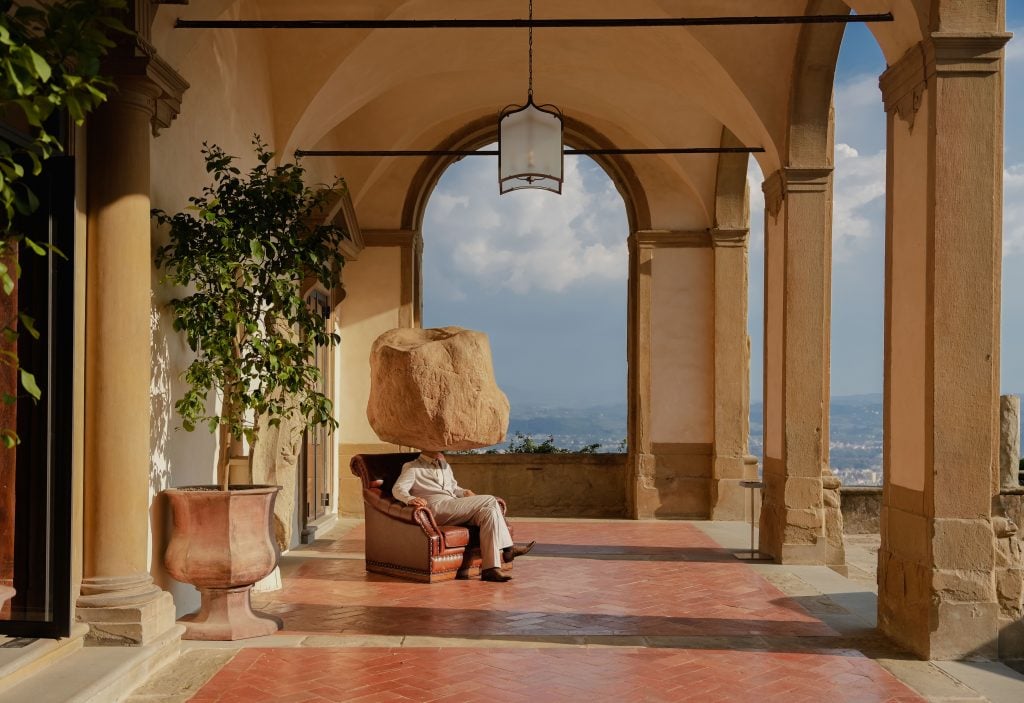
The Belmond hospitality group collaborates with Galleria Continua to pair big name artists with spectacular locales.

William Van Meter

The luxury Villa San Michele hotel is in a revamped 16th-century monastery on the outskirts of Florence. “Picturesque” doesn’t do it justice. Surrounded by potted lemon trees and tiered, lush gardens, it sits atop a hill and overlooks the entire city with clear views of the Duomo and other Renaissance marvels.
The hotel caters to a discerning clientele. When we visited last month, Villa San Michele’s cozy-opulent refectory was occupied by a well-heeled contingent, and it looked like a decadently extravagant party was winding down. A female figure in a taupe ballgown and pearls reclined on a tufted-leather chaise and was orbited by louche gentlemen in sedate, well-tailored suits, gold statement watches, and designer loafers. Oh, and they all had gigantic boulders for heads that weighed 550 pounds and required a crane to install.
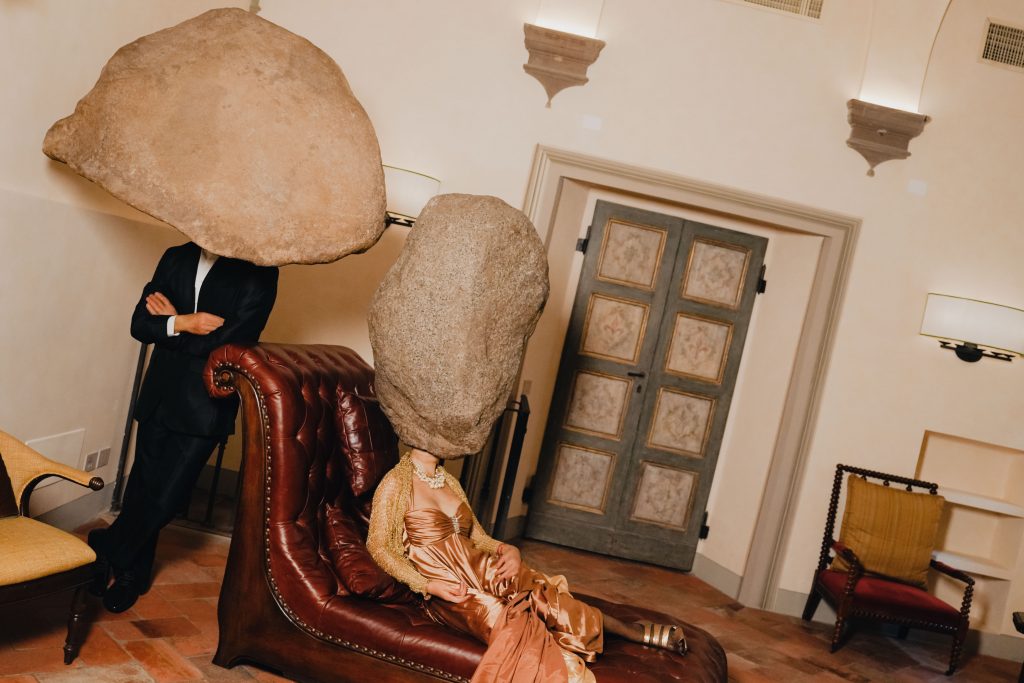
Belmond’s Villa San Michele in Florence featuring works by Sun Yuan and Peng Yu in situ. Photo: Marco Valmarana, courtesy of Belmond and Galleria Continua.
These sculptures, Teenager, Teenager, are by the Chinese collaborative conceptual artists Sun Yuan and Peng Yu and were originally displayed in a Seoul gallery in 2011 accompanied by performances. The artists are pleased with the venue and resonance shift.
“When I first became an artist, I didn’t like to put my works in any everyday places,” Yu explained. “I just liked to put them in the ‘white box’ because in this way the concept of the work would stand out. It’s clean, put your ideas in there. With this, it becomes a part of life. Just like the ubiquitous art of Florence. On every corner is a sculpture by a master.”
She continued, “I like the idea of exhibiting works in a very old environment like Florence. I can’t meet Michelangelo, but we can have divine intercourse with this project in space-time together – a quantum entanglement.”
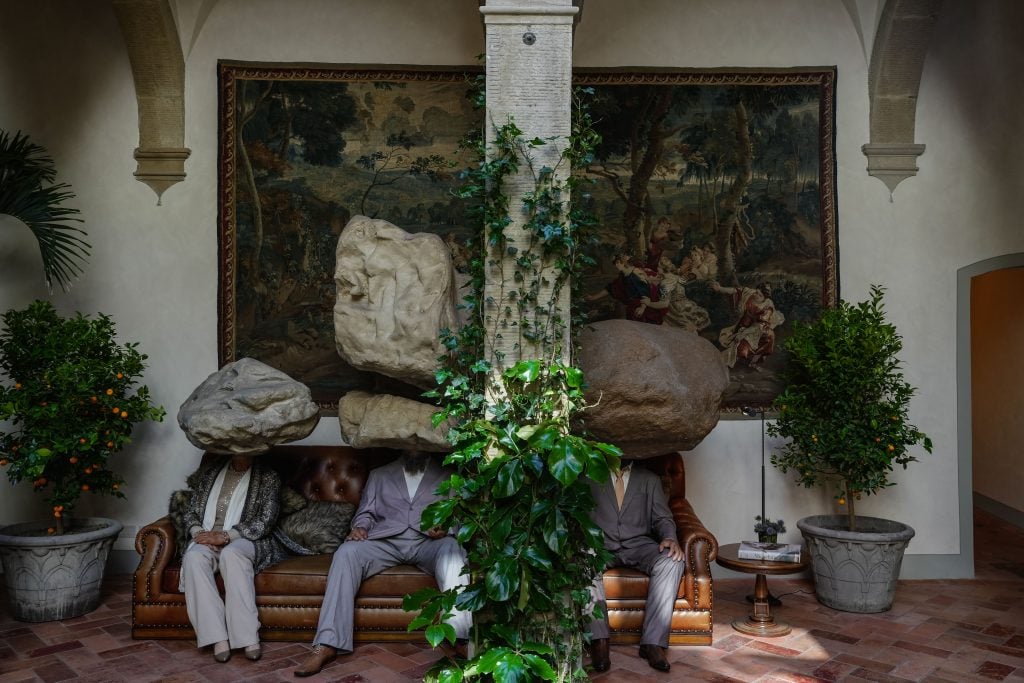
Belmond’s Villa San Michele in Florence featuring works by Sun Yuan and Peng Yu in situ. Photo: Marco Valmarana, courtesy of Belmond and Galleria Continua.
Teenager, Teenager is part of the latest installment of Mitico, the art initiative of Belmond (the LVMH-owned luxury hospitality group whose portfolio of properties is non-pareil). “Our clientele follows contemporary art,” said Sofia Peluso, the general manager of San Michele, who works on the project. “We are not really a typical hotel either. Art is one of the key components we are offering the guests.”
Mitico’s aim is basically to place a mix of curated and commissioned pieces by renowned artists in the hotels for short term stays – mini pop-up solo shows seamlessly incorporated into the hotels’ rhythms. The artwork functions on two levels. The aficionados who “get it” will appreciate temporary intimate cohabitation with works of such stature. The casual guest who isn’t as plugged in will still think it’s some cool stuff to take a selfie next to.
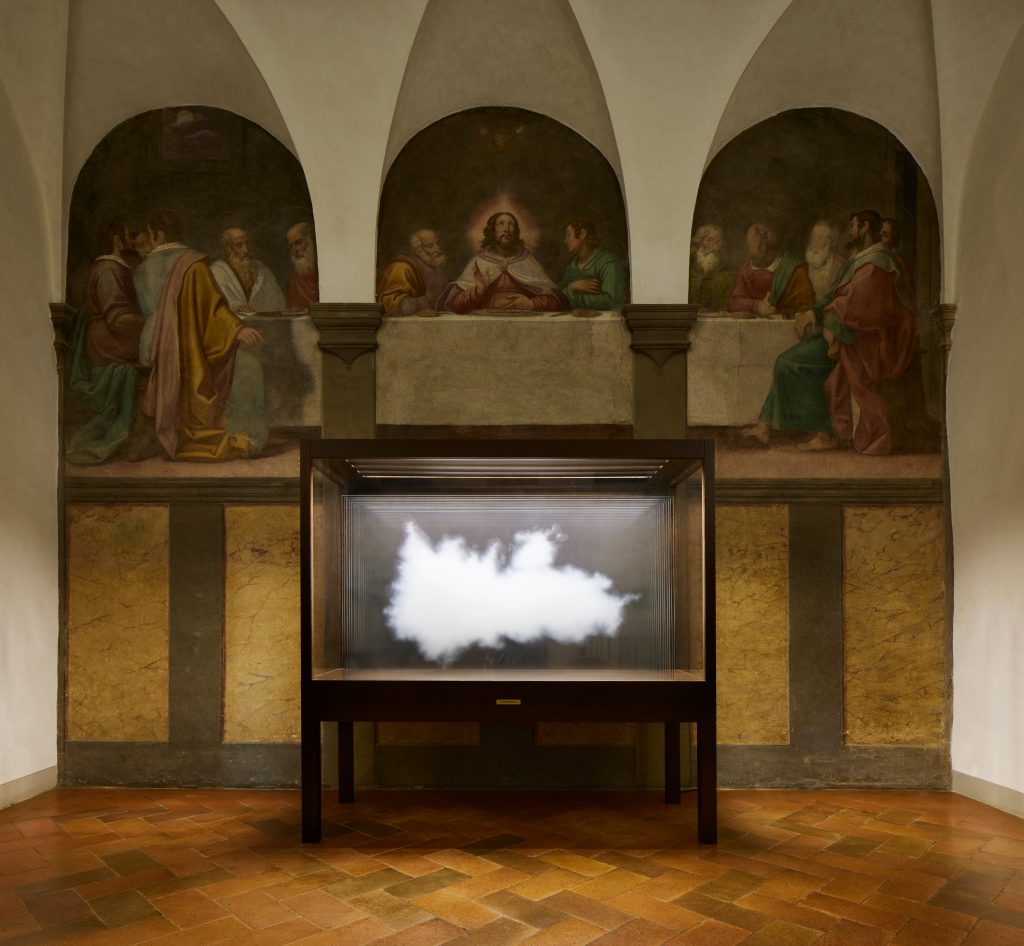
The Cloud UK (2016) by Leandro Erlich, currently housed at Villa San Michele, A Belmond Hotel, Florence. Photo: Agostino Osio, courtesy of Belmond and Galleria Continua.
Sometimes the art just doesn’t want to check out, though. Case in point, the Argentine multimedia artist Leandro Erlich’s sculpture from last year’s inaugural Mitico is still across the room. It was such a hit with guests and staff that the loan was extended. The Cloud UK is akin to a cumulus captured in a terrarium and it looks amazing underneath Nicodemo Ferrucci’s fresco (completed in 1606) of the Last Supper.
For generations, this room was the cenacolo where the friars gathered for dinner. Years of accumulated smoke, dust, and debris obscured many of the fresco’s details and dulled its colors. Upon restoration, it was discovered that a mischievous white kitten was peeking out from beneath the table. A window revealing a cloud-filled sky turned up behind the assembled apostles, subtly echoing the modern sculpture below. Erlich’s “Window & Ladder” has been purchased and is now a permanent fixture on the grand lawn surreally punctuating the Renaissance skyline.
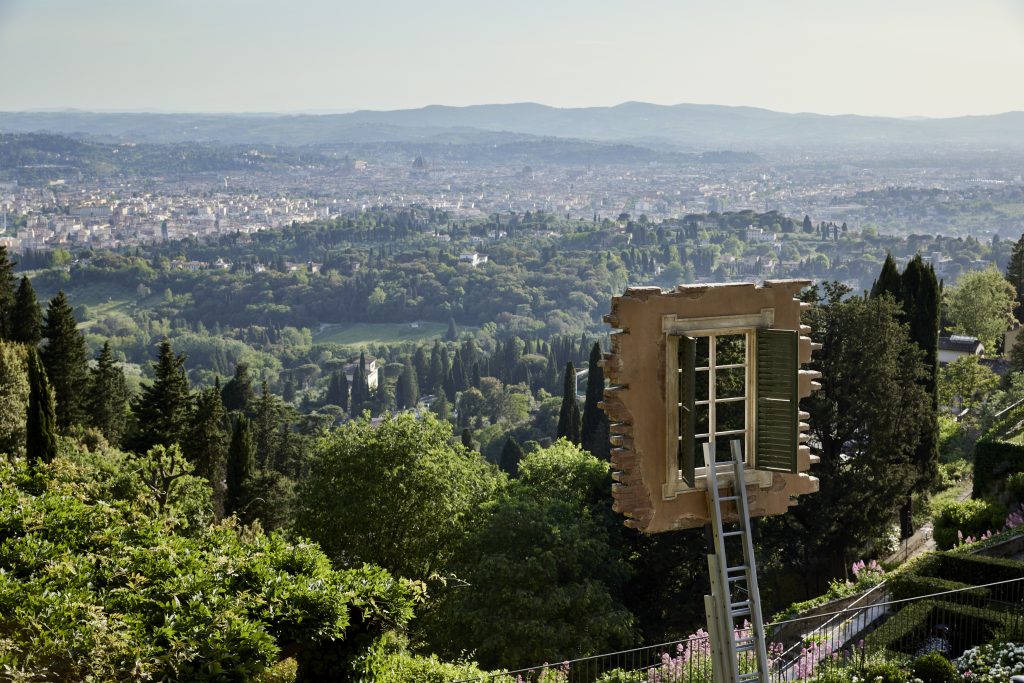
Leandro Erlich’s Window & Ladder (2022) accentuates the view at Villa San Michele, A Belmond Hotel, Florence. Courtesy of Belmond.
Bringing high art into a hotel is not a new concept. But the art world pedigree behind Mitico’s partner, Galleria Continua, sets it apart. It’s as elevated as a partnership can get. The contemporary art space was founded in 1990 in a former cinema in the fortified medieval hilltop town of San Gimignano, about 35 miles southwest of Florence–a modern anachronism in the ancient city. The town is a UNESCO site and an immersive archaeological experience that is a mecca for tourists. It boasts a combination of Romanesque and Gothic architecture as well as two torture museums.
Galleria Continua became a draw for a much different visitor and has grown to be global powerhouse with outposts in Paris, Beijing, Rome, Sao Paulo, Havana, and Dubai. One of Galleria Continua’s three founders, Lorenzo Fiaschi, curates Mitico from his gallery’s impressive roster.
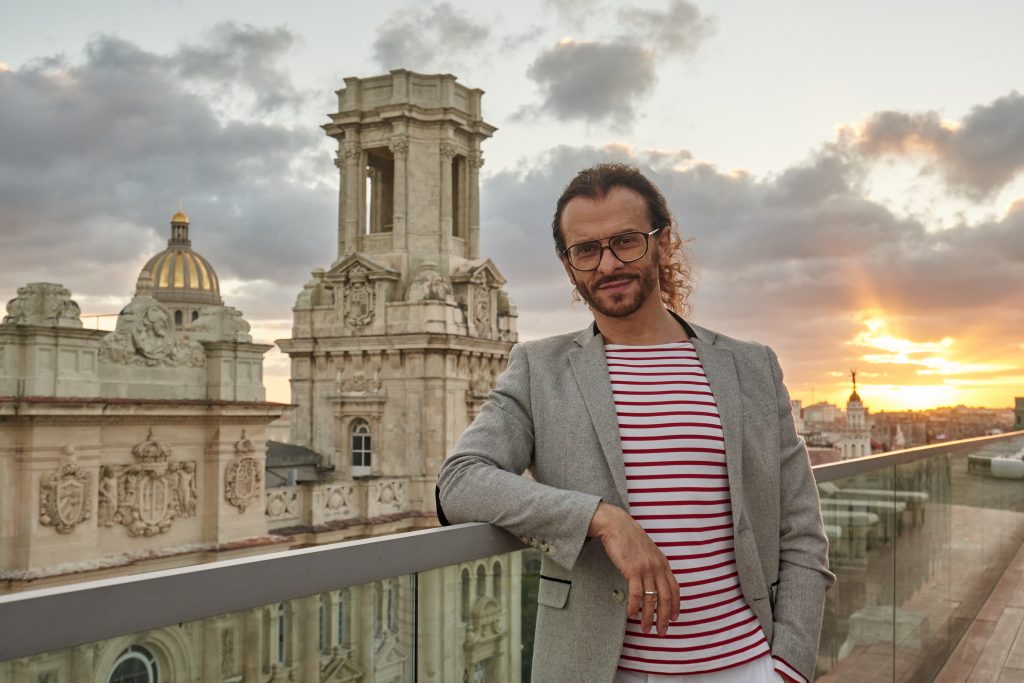
Galleria Continua’s Lorenzo Fiaschi curates Belmond’s Mitico arts initiative. Courtesy of Galleria Continua.
“As you can imagine, it can be challenging with a historical place,” Fiaschi said, holding court in a cream corduroy suit in the refectory among the Teenager, Teenager demimonde. “It’s not easy to find the correct work. Our job is to find the synergy.”
He continues, “Galleria Continua has done so many projects. Thirty years ago, we put Anish Kapoor in a church. If you ask an artist directly, would you wish to show in a hotel…well, no thank you. Because for them it’s not normal. But the truth is, they trust us.”
Other artists featured for this season of Mitico are Yoan Capote at Grand Hotel Timeo, Sicily, Arcangelo Sassolino at La Residencia, Mallorca, and a yet-to-be-announced installation will launch in September during Art Rio at Rio de Janeiro’s Copacabana Palace. Nari Ward was on hand for the vernissage of his piece Stallers (2013) at Castello di Casole.
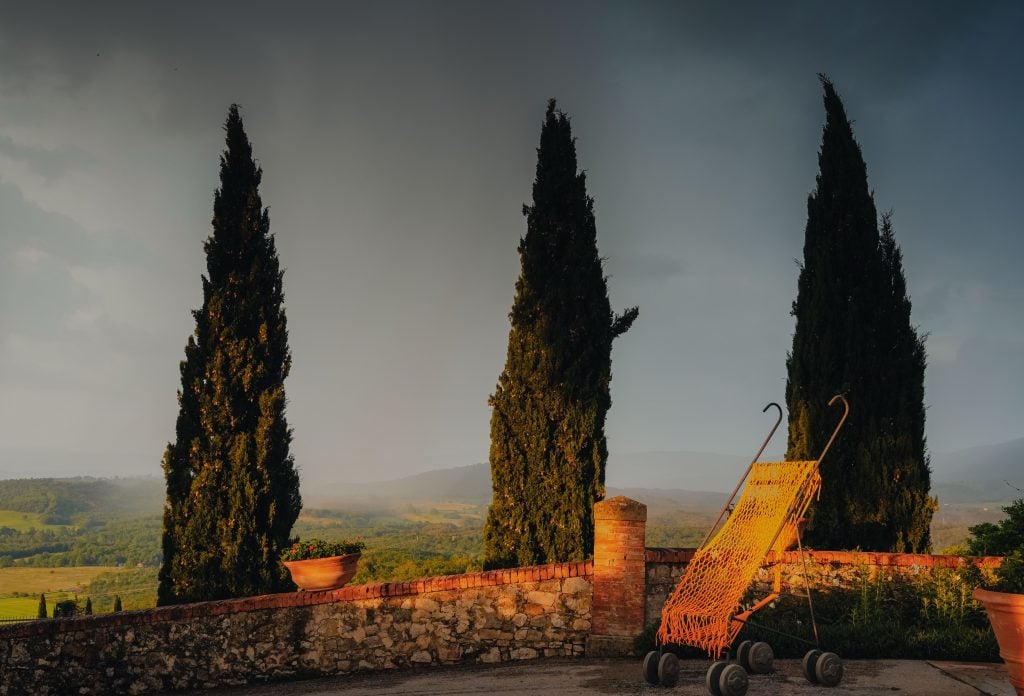
One of Nari Ward’s Stallers sculptures at Castello di Casole. Courtesy of Belmond and Galleria Continua.
It is hard to quantify the transportive grandeur of the 10th century Tuscan country estate situated upon 4,200 acres. An ancient outdoor amphitheater is surrounded by fragrant fields of unruly roses, orchards of olive trees, and an infinity pool with a sumptuous view of an endless expanse of rolling hills and virgin nature. The hotel doubles as a functional farm and creates its own wine and olive oil from its vineyards and honey from its hives.
Instead of attempting to compete with paradise, Ward cheekily offset it with his 19 gargantuan, garishly colored stroller sculptures. The artworks are jarring juxtaposed against the elysian environment and double as functional hammock-like cocoons.
“You sit down to reflect in on yourself or reflect out into the landscape,” Ward explained, beatific in a cowry shell ankh necklace and circular sunglasses and beanie as he sat beneath the gold and turquoise stained glass in the hotel’s chapel before that evening’s festivities. The experience of sitting in the sculptures is the compelling message for the artist.
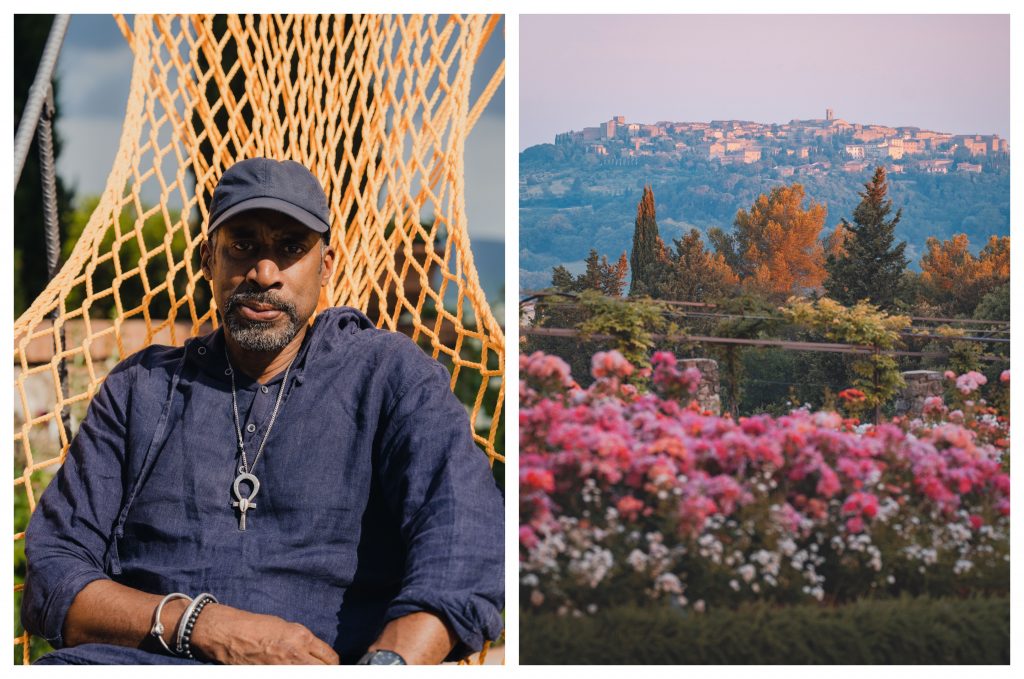
The artist Nari Ward and a view from Castello di Casole. Courtesy of Belmond.
“I’m always thinking about ceremony,” Ward says. “Sometimes I create my own idea of the sermon of performance that needs to happen. The idea about re-imagining the experience of the work for the viewer. Looking around you and thinking about it in a way that you wouldn’t have, perhaps if you sat on a tree stump. It moves you in a different way.” He adds, “There’s an element of high theater to it.”
Stallers isn’t Ward’s first work incorporating strollers. His seminal, haunting 1993 installation Amazing Grace was comprised of 310 of them, scavenged from the Harlem streets and reflecting a community in crisis. Stallers shows the other side of the coin—not a redress but a celebration of life. Instead of gathering grim ghostly objects that had been abandoned, he’s leaving joyous ones behind.
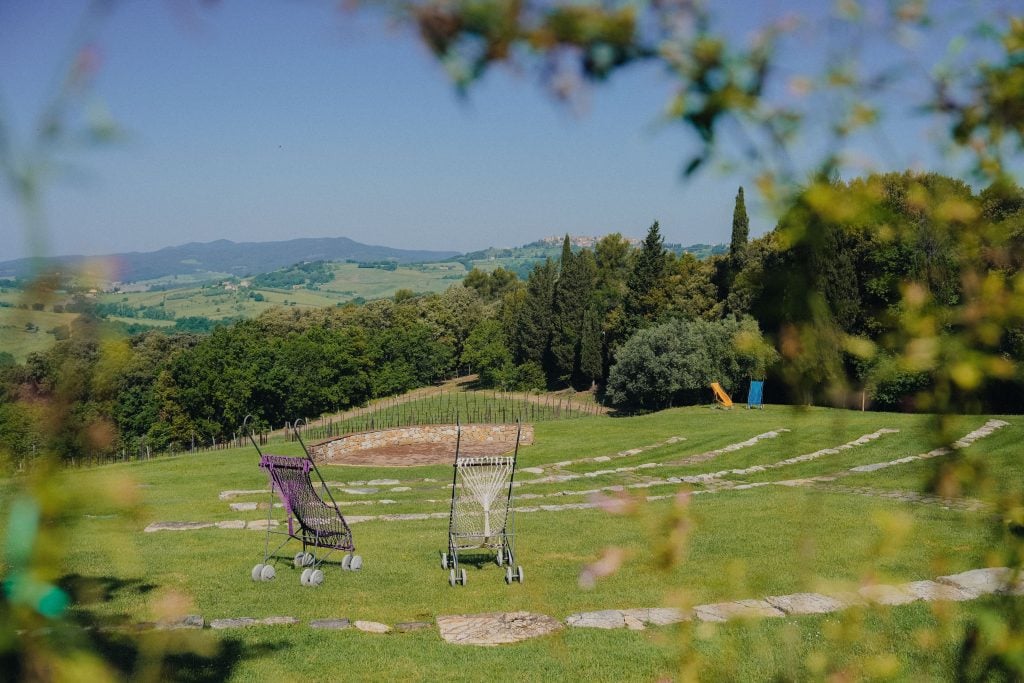
Nari Ward’s Stallers sculptures sit atop an ancient onsite Etruscan amphitheater. Courtesy of Belmond and Galleria Continua.
“I really wanted to figure out how to come back to the essence as a space of meaning,” Ward says. “It was important to me to think about this little vehicle, this tool. We leave our parent’s body and we’re pushed into the world. This piece is called Stallers, and I was really thinking about this idea of being stopped, kind of a waiting position. I was interested in this idea of waiting and how this could be layered or somehow politicized. There are many possible interpretations of this vehicle.”
He continued, “I wanted it to be humorous. There’s a moment of joy and laughter, because whoever sits in it immediately becomes an infant. You can’t move and it doesn’t go anywhere. But it does allow you to just meditate on the environment. I was interested in creating a space of introspection in relationship to the landscape.”